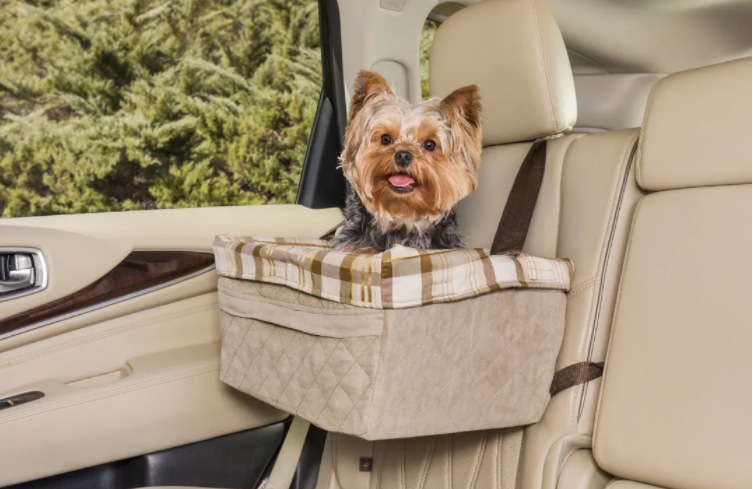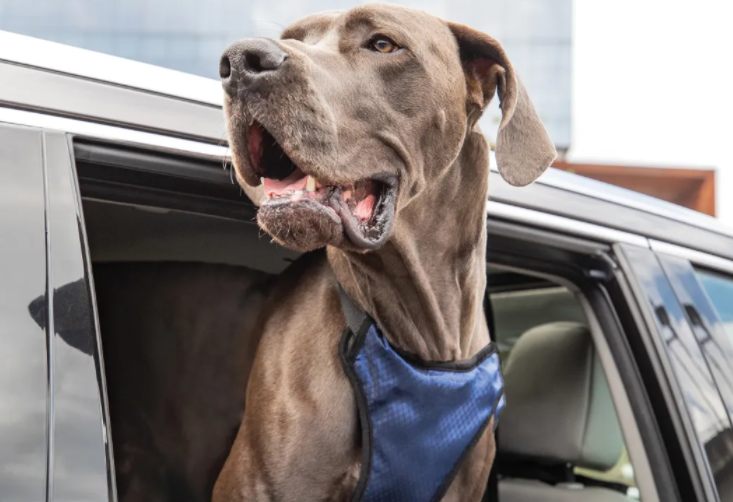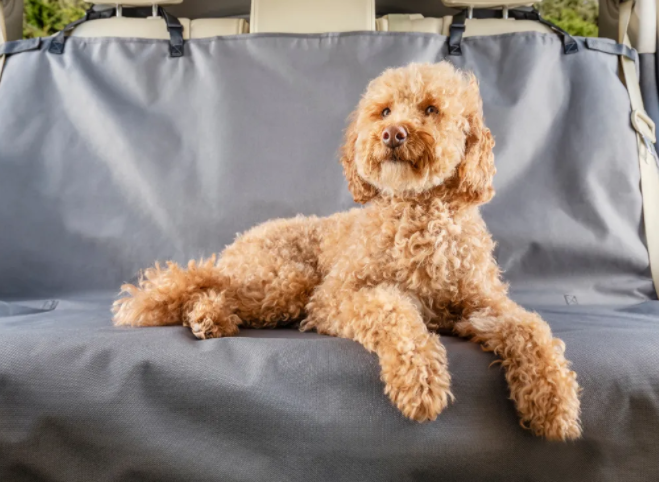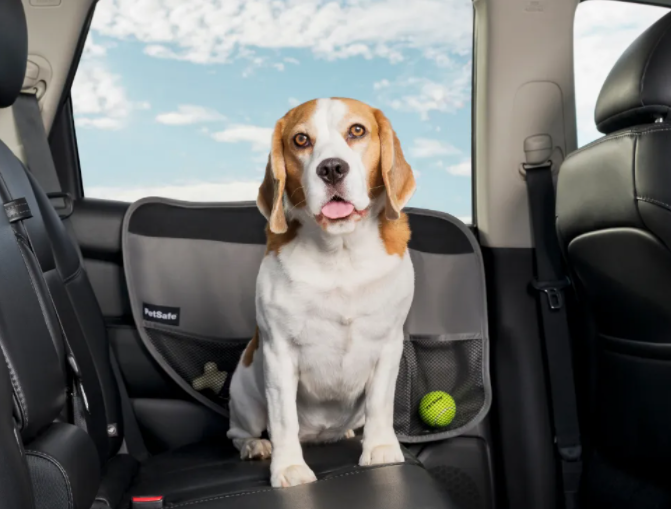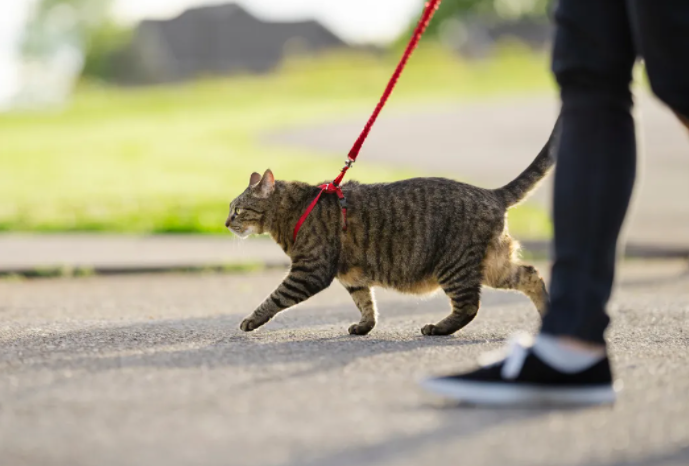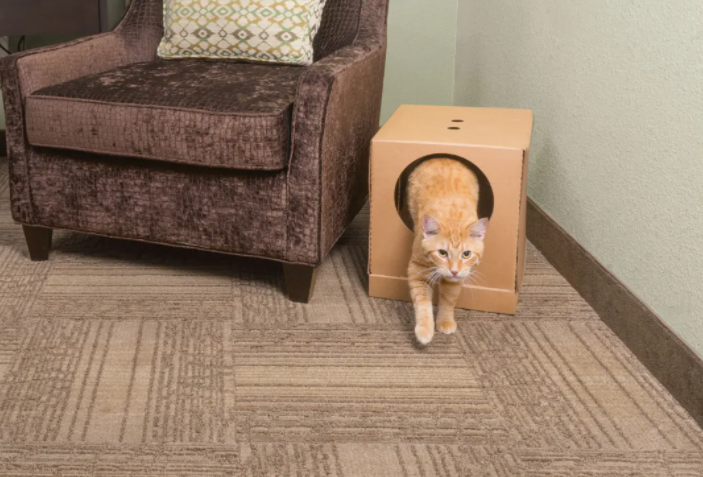Written by Rob Hunter
Whether you’re taking a vacation or heading home for the holidays, it’s always an added treat to bring your furry family members along for the ride. Traveling with dogs or cats can be challenging at times.
It’s important to be prepared so you and your buddy can enjoy the journey and the destination together. Dogs and cats each have specific needs for pet parents to attend to while traveling, but a few key considerations are important for all pets:
Never leave your pet alone in a vehicle. Even on deceptively cool or cloudy days, the inside of a car can get dangerously hot in just a few minutes. As sunlight passes in through the glass, it warms up the interior and that heat becomes trapped in a phenomenon known as the greenhouse effect. Even with windows slightly open, heat can build up quickly in a sunlit vehicle, leading to temperatures that can cause illness, injury and even death for pets and people.
According to the Humane Society of the United States, a car’s interior can heat up to 116 degrees Fahrenheit within an hour on a 72-degree day. While rolling windows down might help keep it cool, this exposes your pet to other potential dangers, including car thieves or escape through an open window. As with a young child, it’s best to never leave a pet alone in a car, even for short periods.
Think about whether the trip is right for your pet. Before asking how to travel with a cat or dog, consider whether you should bring your pet along on your trip. While we’d love to bring our pets with us everywhere, it’s important to be mindful of what is best for each pet. Some trips and destinations may be stressful or dangerous for pets.
As we’ll explore, there are many solutions available for keeping our buddies safe and comfortable while traveling, but in some cases, it’s simply best for the pets to leave them at home with a trusted pet sitter. Always plan your trip in advance. If you’re considering bringing your pet, check on whether your transportation and your destinations are pet-friendly. If you’re not sure whether a trip will be safe or enjoyable for your pet, consult your veterinarian.
Before you go, find a local vet at your destination. Though no one likes to think about it, there is always a chance that your pet could require medical attention while you’re traveling together. To make sure you’re prepared in case of emergency, look up veterinary services in the area you’ll be visiting. Hopefully you won’t need it, but in case you do, keep the phone number and address of a local veterinary clinic with you at all times.
The American Veterinary Medical Association also recommends that you bring a Certificate of Veterinary Inspection along with vaccination records to ensure you’re in compliance with local regulations wherever you go. Ask your family veterinarian about these documents well ahead of your trip.
Traveling With Your Dog
Traveling with dogs can be lots of fun. Many dogs absolutely love a good trip in the car. The familiar phrase “Wanna go for a ride?” can be like music to a dog’s ears. We’re all familiar with the image of a dog peeking out of a car’s window on the highway, joyfully letting his ears, his tongue and often his drool fly in the breeze. But every dog is unique, and a long interstate trip is quite different from a quick cruise to the dog park.
Before every trip, long or short, be sure to consider your own pup’s experience and anticipate his needs to ensure a safe, comfortable and fun experience for everyone.
Here are some tips for how to travel with a dog.
Safety Tips
Help your dog get in and out. Before we look inside the vehicle, consider how your dog gets in and out. Does your dog ever struggle to jump up into the car? Does he hesitate to jump down? Do you ever strain your back having to bend down and give him a boost? For many pet parents, the answer is yes to all of the above. Dog ramps and steps are a great way to take the effort out of loading and unloading your buddy into the vehicle, saving his joints and yours at the same time!
Put your dog in the back seat. When it comes to keeping your pup safe in the car, the recommendations for your pup are often the same as those for small children. Because of their size and posture, it’s best to keep dogs out of the front seat. Airbags are designed to keep adult people safe in an accident, but the way they deploy can actually injure a dog, even if he’s in a special seat or a carrier.
Additionally, It’s important for everyone’s safety to keep your pup in the back where he won’t distract the driver and risk causing an accident. If your dog is a restless passenger who likes to crawl up front and into your lap, consider getting a reliable dog barrier or a zipline to prevent him roaming into the danger zone.
Speaking of safe seating, never place your dog in an open truck bed. Unsecured dogs are at risk of jumping or falling out while the truck is in motion, and dogs secured with lines or leashes can become dangerously entangled before the driver notices.
Buckle up your pup. Though seat belts are designed for human passengers, there are a variety of products available that adapt the benefit of seat belts to our canine copilots. The simplest is an adjustable seat belt tether that allows you to anchor your dog’s harness to the buckled lap belt.
For additional security, consider a crash-tested safety harness that’s designed to attach to a seat belt tether in the car or to a leash when you reach your destination.
If your pampered pup is under 30 pounds, he might be eligible for his very own dog safety seat. Like a child’s car seat, these connect your vehicle’s seat belts to help keep your buddy safe in the event of an accident.
Equip your dog with contact info. No one likes to think about the possibility of our pets getting lost while in an unfamiliar place. Unfortunately, dogs sometimes get loose and run off during rest stops or at travel destinations.
To avoid this scary situation, first and foremost, make sure your pup is on a leash at all times when you first visit a new place or when you stop along the way. In the event that your dog does somehow get away from you, it’s very important that he has identifying info with him. The traditional way to do this is with a collar and tags. Make sure his ID tags include your home contact information, as well as the number and address to contact you while you’re at your travel destination.
In addition to tags, it’s a great idea to get your dog microchipped. This tiny, harmless chip, placed just under the skin by a veterinary professional, can be scanned by a vet or animal shelter employee to quickly find your dog’s information (often including your contact info) on a national database.
Comfort Tips
Consider seat covers, booster seats and more. Like seat belts, most vehicle seats are designed with human passengers in mind. One of the easiest ways to make your car, truck, minivan or SUV more dog-friendly is with handy waterproof seat covers, often available in bucket, bench and hammock styles to fit most seats in most vehicles.
Seat covers are great for keeping dog hair, muddy paw prints and other pup messes off your seats. Even small dogs can have their very own window seat with a comfy booster seat that includes a safety tether and attaches easily to a car seat headrest. These keep small dogs from wandering in the car and often help them relax by letting them watch the world go by out the car window.
While some dogs are excited to look out the window, others are content to snooze until you reach your destination. For these pups, a cozy car dog bed is the perfect blend of seat cover and dog bed.
Make regular pit stops. Be sure to stop regularly for brief, leashed walks to let your dog potty and stretch his legs. For long trips, consider looking up off-leash dog parks along your route. Some rest stops and travel centers offer fenced areas specifically for dogs.
Pit stops are also the best time to offer your dog water, as it’s usually difficult to maintain an open water bowl in a moving vehicle. A handy pet travel bag can help you keep track of your buddy’s food, water, treats and poop bags while on the road.
Make your destination feel like home. Your dog will be most comfortable at your travel destination if you can make it feel familiar for him. One effective way to do this is to bring his favorite blankets, dog beds and toys along. Give him time to explore his temporary home away from home so he can get used to the sights, sounds and smells.
If he’s allowed on the furniture, consider a lightweight set of portable pet steps to help him get up and down. Choose an easily accessible spot for his food and water.
Speaking of food, another way to help your buddy feel at home is to maintain his normal eating routine. If your trip’s itinerary makes this a challenge, an automatic pet feeder can help ensure your buddy gets his meals on time, every time, even if you’re late getting back to your hotel room or Airbnb.
If your buddy seems anxious about his new surroundings, consider an interactive dog toy to focus his attention on fun while he’s getting acclimated.
Dog Travel Checklist
Here’s a handy list summarizing common items to make traveling with your dog safe and comfortable for everyone:
- Collar and ID tags with contact information
- Leash and harness
- Poop bags
- Dog food
- Water
- Food and water bowls
- Dog ramp or steps
- Dog barrier or zipline
- Waterproof seat covers
- Seat belt tether, safety harness or safety seat
- Booster seat or car dog bed
- Pet travel bag
- Automatic pet feeder
- Beds, blankets and toys from home
Traveling With Your Cat
Cats are generally less enthusiastic about car rides than dogs tend to be, and many cats are more comfortable staying at home with a pet sitter. If your cat is the homebody type, you can set her up for stay-at-home success with a smart pet feeder, and a self-cleaning litter box.
But just because some cats prefer to stay at home, this doesn’t mean cats can’t travel! There is plenty you can do to make traveling easier on your feline friend. Here are some tips for how to travel with a cat in a car.
Safety Tips
Use a pet carrier. Cats typically feel safer in a small, sheltered space while in a moving vehicle. Additionally, you don’t want to risk your cat wandering into the front seat while you’re driving, or escaping out an open door or window at a rest stop. It’s best to place your cat in a designated carrier or crate at home and let her stay there until you reach a secure, indoor destination. Pets can behave unpredictably in new places, and you don’t want to risk your cat slipping away and running off in a strange new place.
Cat carriers can be soft or hard, and come in a variety of sizes and styles. Hard-sided carriers are generally the safest. It’s best to introduce your cat to her carrier slowly, with plenty of time for her to adjust before you travel together. If your cat becomes comfortable entering the carrier at home, it’s much easier and less stressful for her (and you) to use the carrier when traveling.
If you have multiple cats, each one should get her own carrier. Cats can get irritable if they have to share small spaces, and traveling with cats in cars is much safer without the risk of feline fights breaking out!
Check on your cat often. Some cats curl up in their carriers and don’t make a peep until the trip is over, whereas other cats may get talkative while you’re on the road. While the carrier is the safest place for your cat to be in a moving vehicle, you can’t always see what she’s up to while you’re driving. Make sure to stop regularly to see that she’s comfortable and content in her carrier.
Break up long trips. Unlike dogs, who can hop out on a leash for walks at each pit stop, cats should generally remain in their carriers until you reach your destination. If you plan to be on the road for many hours, consider giving your cat a break by staying overnight along your route.
For example, rather than driving 16 hours straight through, staying in a hotel for a night after driving 8 hours will give your cat a much-appreciated chance to move around, eat, drink and potty outside her carrier.
If you do want to give your cat the chance to stretch her legs at pit stops, consider a harness and leash made especially for cats to keep her safely by your side.
Equip your cat with contact info. As with dogs, you should always make sure your cat carries her identification with her, either on ID tags attached to her collar, or in a microchip. Include the contact info for your destination as well as home.
If your cat somehow goes missing, this will help anyone who finds her to get in touch with you quickly and easily so you can be reunited as soon as possible.
Comfort Tips
Give your cat room to move (but not too much.) When setting your cat up in a pet carrier or crate, make sure she has enough room to stand up and to turn around – but not much more than that. The idea is to give her just enough room to get comfortable, without being able to roam around or be jostled while the vehicle is moving. A comfy blanket or pet bed can help her feel more relaxed and cozy, but make sure you don’t stuff more items in there than she needs. Choose a carrier appropriate to your cat’s size and line the floor with soft bedding, but don’t pile toys or blankets in a way that crowds her out.
Use a travel litter box. One of the most challenging parts of traveling with a cat is managing the litter box. Most litter boxes aren’t very practical for use at a pit stop or while visiting a travel destination.
That’s where a disposable litter box comes in handy! Made of sturdy, leakproof cardboard, this portable travel toilet gives your cat a portable place to go, anytime, anywhere. Complete with disposable scoops and odor-absorbing crystal litter, a disposable litter box even folds up for storage so you can pack it away until it’s time for a potty break.
At your destination, choose a quiet spot that’s easy to access. Watch your cat to be sure she finds the litter box and that she’s using it. If you find that she’s having accidents outside the box, try moving the box close to where she has gone – she may prefer that location. Like a carrier, a disposable litter box will be most useful if you acclimate your cat to it well ahead of your next trip.
Make your destination feel like home. Help your cat feel more comfortable at your destination with familiar items like beds, blankets and toys. Before you let her out of her carrier, make sure to check out the place to ensure there are no potential risks for your cat such as open windows, toxic houseplants, or narrow spaces where she may try to hide.
Place her carrier in a quiet corner and give her time to acclimate before you open the door. It’s a good idea to leave her carrier open in a comfortable, secluded spot for the duration of your stay. This way, your cat always has a secure, familiar place she can go when she feels like it.
If your cat is restless upon your arrival, consider an interactive laser cat toy to help her work off some of that pent-up energy.
Some cats are reluctant to eat or drink when they first arrive in a new place. Offer food often, and if she is hesitant to eat, place some food in her carrier so she can eat when she feels comfortable doing so. If she seems reluctant to drink, try a pet fountain. Many cats prefer to drink moving water, so a pet fountain can encourage her to drink when she’s distracted by new surroundings.
Cat Travel Checklist
Here’s a list of items to make traveling with a cat safe and comfortable:
- Collar and ID tags with contact information
- Cat food
- Water
- Food and water bowls
- Carrier
- Cat harness and leash
- Pet travel bag
- Disposable litter box
- Cat litter
- Pet fountain
- Beds, blankets and toys from home
Traveling with a pet can seem like a daunting experience, but with careful planning and preparation, you and your furry family members can enjoy every step of the journey together. At OWON-PET®, we’re dedicated to helping you keep your pets healthy, safe and happy everywhere you go. Here’s to peaceful purrs, wagging tails, and happy trails!
Post time: Apr-25-2022

